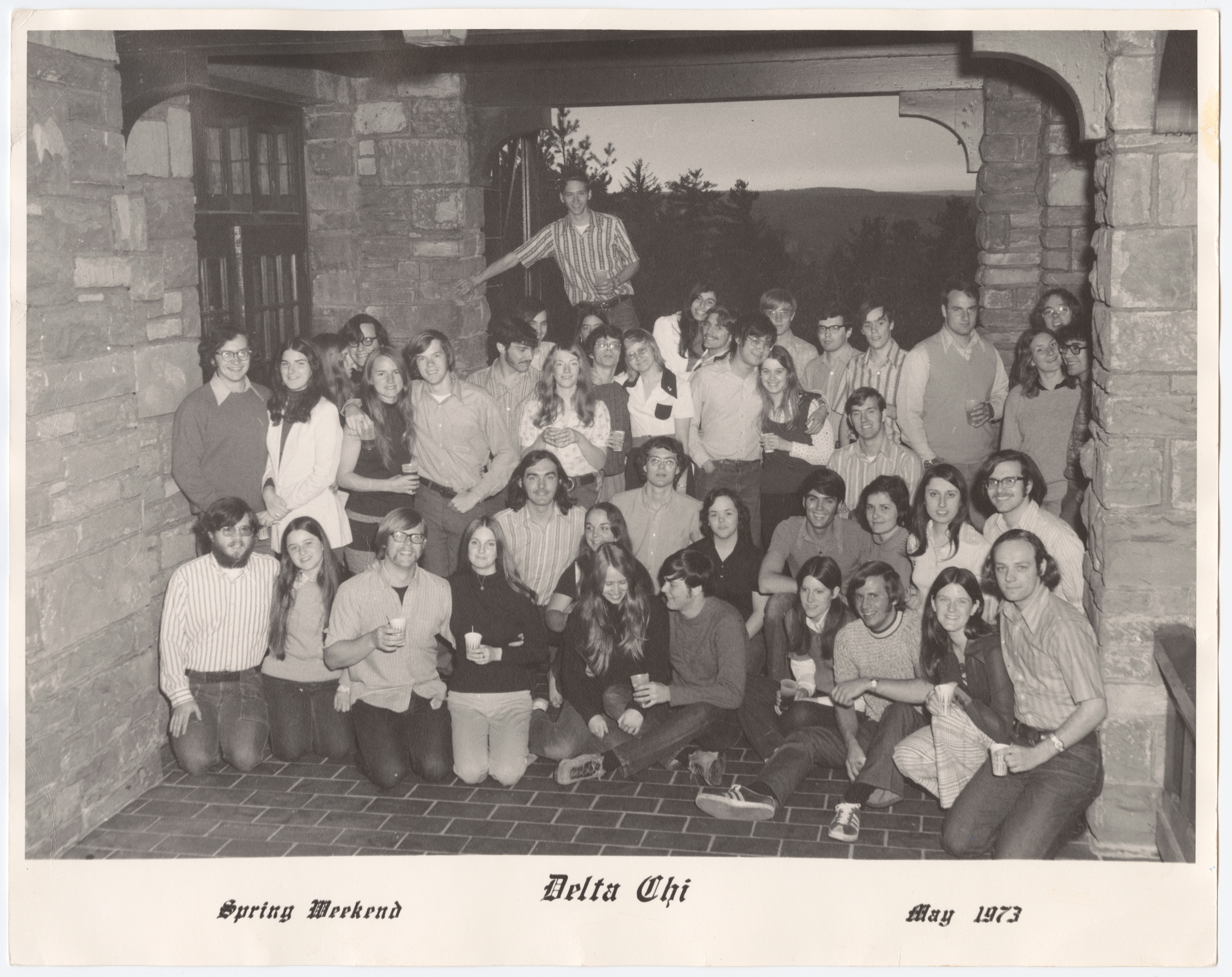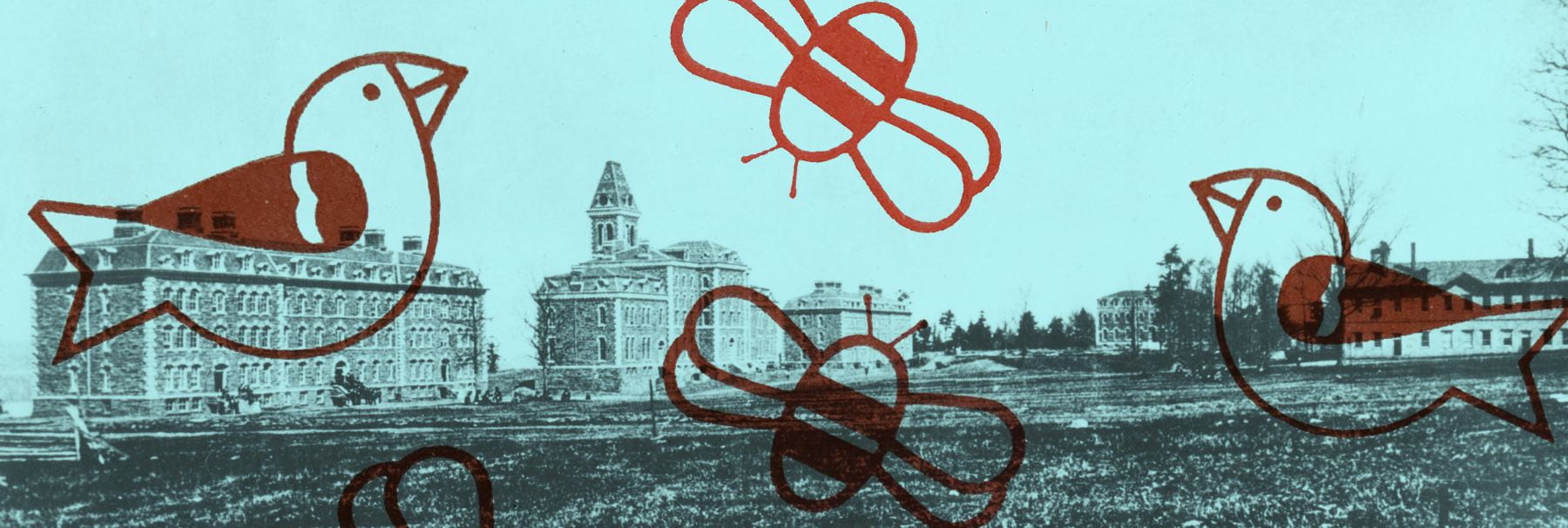
Fighting for more than a MRS degree: Contraception, abortion, and equal access to education
Imagine you are a young woman in 1968. This was four years before Title IX, which prohibits sex-based discrimination or exclusion in any education program, became enshrined as a right. You entered Cornell in the fall, eager to start a new chapter of your life. Cornell was among the few options that accepted women, and it was among an even fewer pool with a strong science program that accepted women. Four years after the first female students enrolled in 1871, Cornell opened Sage College for Women[1]. Sage Hall became a graduate student dormitory in the 1930s[2], so by the time you arrived, you and your fellow college women started the journey in the women-only North Campus residential halls (Risley, Comstock, Balch, Donlon, and Clara Dickson)[3]. What challenges did young women have to overcome to claim their education at Cornell?
Girls on the Hill
Curfew
The first challenge a college girl faced was the curfew.
“We (girls) were treated like children, and I freely admit now looking back that at 17, I probably was a child, but not as much one as that 12-year old boy.”
Curfew was a shared experience for all female Cornell students at that time, including Linda Barufaldi (’69)[4] and Diana Petitti (’71)[5]. Barufaldi recalled how ridiculous she felt when a 21-year old woman had to “stay in before eleven on Friday night” while a 12-year old boy in her class did not: “We (girls) were treated like children, and I freely admit now looking back that at 17, I probably was a child, but not as much one as that 12-year old boy.”[4] While your male peers could freely enjoy the night, you were restrained from various campus activities that took place after the curfew. Barufaldi missed her overnight fasting protest in the Arts Quad for the antiwar movement as a result[4]. Viewing itself as a parent, the university held strict regulations on student behaviors—and female students were perceived as less mature than males, even those who were much younger in age.
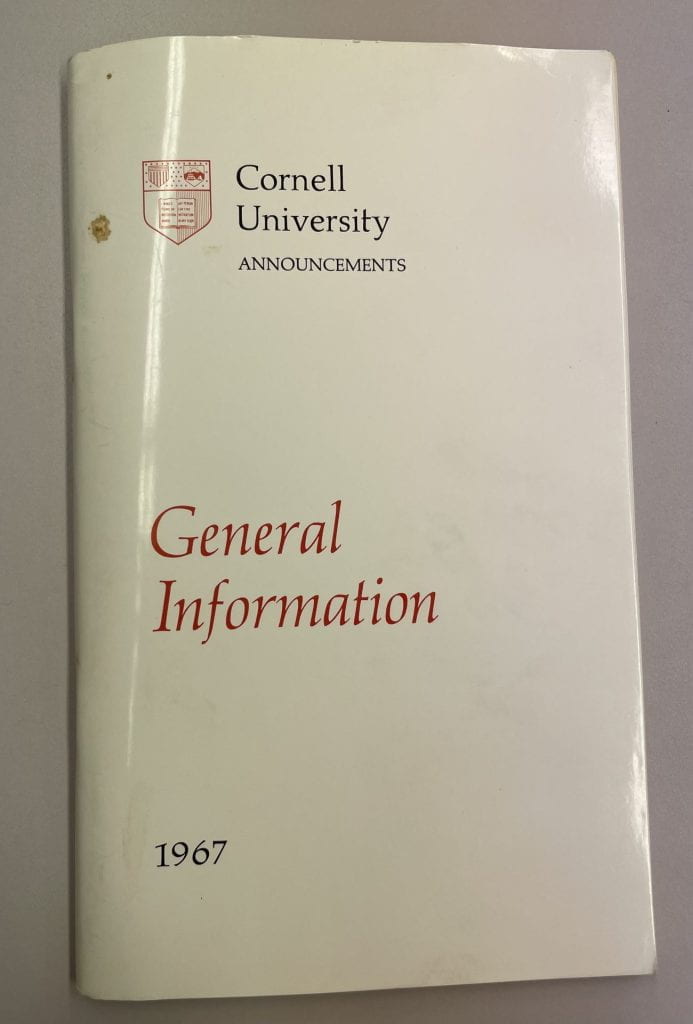
Excerpts from General Information 1967, a booklet handed to Cornell students. Note how Cornell men had a bevy of dining and living options compared to Cornell women. June F. Brooks Papers, #37-5-3886 (box 1). Division of Rare and Manuscript Collections, Cornell University Library.
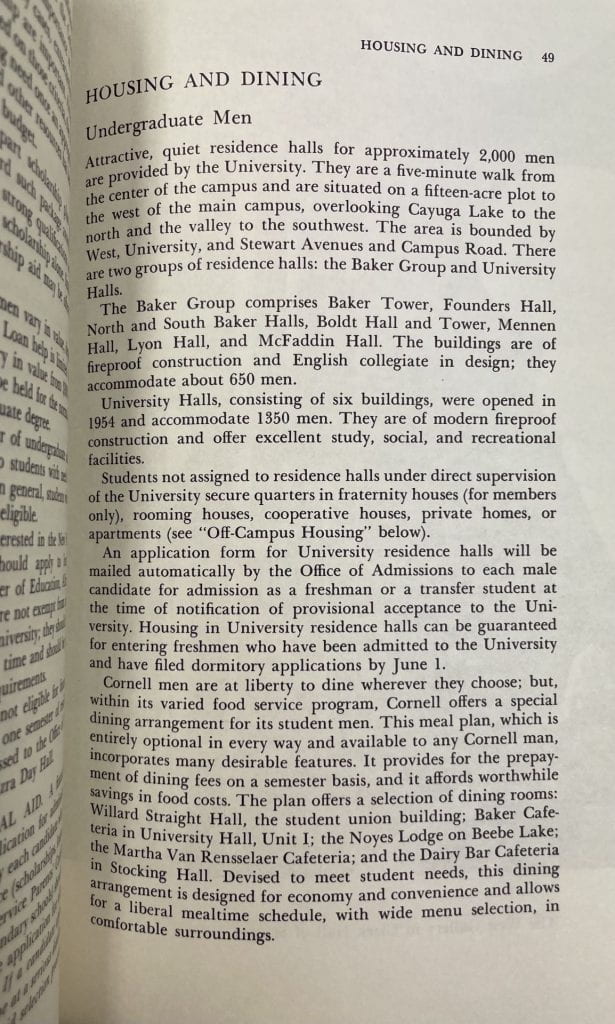
Excerpts from General Information 1967, a booklet handed to Cornell students. Note how Cornell men had a bevy of dining and living options compared to Cornell women. June F. Brooks Papers, #37-5-3886 (box 1). Division of Rare and Manuscript Collections, Cornell University Library.
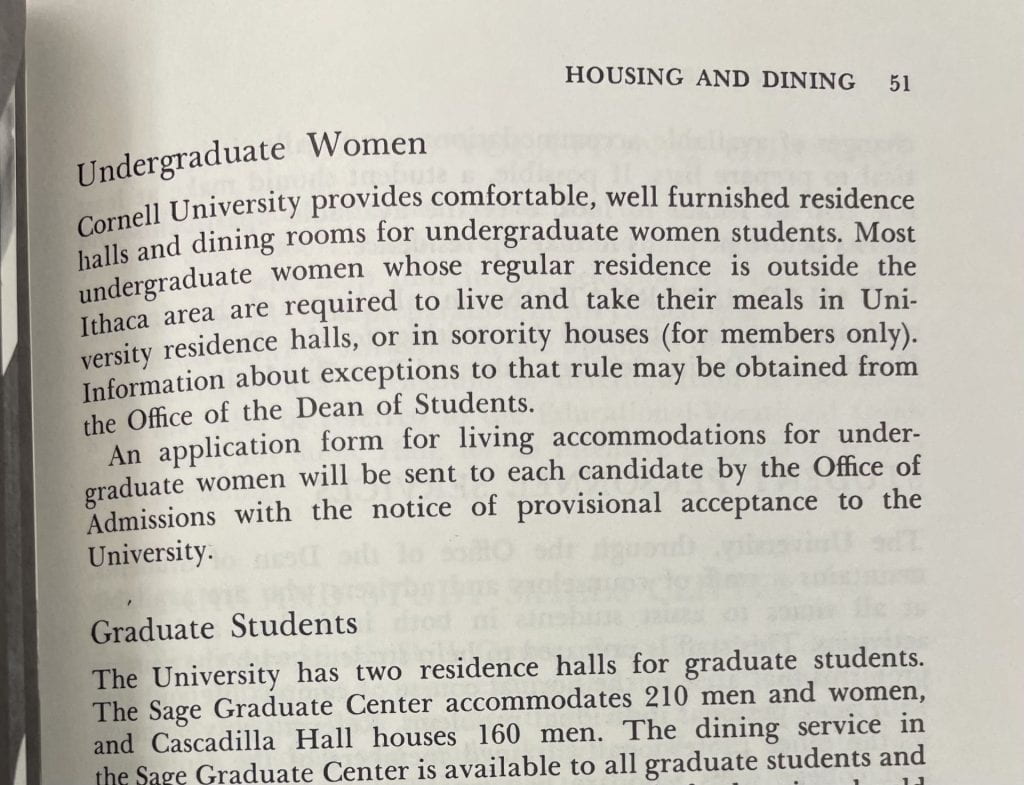
Excerpts from General Information 1967, a booklet handed to Cornell students. Note how Cornell men had a bevy of dining and living options compared to Cornell women. June F. Brooks Papers, #37-5-3886 (box 1). Division of Rare and Manuscript Collections, Cornell University Library.
Women’s Self Government Association (1922). Some Things Not Counting as Nights Out. https://rmc.library.cornell.edu/cornell150/exhibition/sexcolor/index.html
After the court case Dixon vs. Alabama in 1961, which ruled that universities could not paternalistically act in loco parentis to discipline students, curfew was challenged in many colleges nationwide. The Women Self-Government Association (WSGA) of Cornell eventually lifted the curfew for female students in 19691. Student feminist organizing and activism spurred the policy changes to which they were legally entitled.
Residential Life
Until 1973, all female students were required to live on campus. While male cohorts could live freely in fraternity houses or off-campus apartments, women were required to live on the hill in the few residential dormitories on North Campus. Given that students living on campus could not keep a car, and the public transportation services in Ithaca were barely started, women were somewhat isolated on the hill, “in positions of dependency with men who had cars,”[5] according to Diana Petitti. Moreover, while “Cornell men are at liberty to dine wherever they choose”, women had to take meals in their residence halls or sorority houses. If they missed the meal service hours, there was no other option but to stay hungry[3].
In the 1960s, all North Campus dormitories were women only[3]. In 1968, Linda LeClair at Barnard College was expelled due to living with her boyfriend[7], resulting in waves of protests across various campuses[6],[7]. Universities eventually adjusted their residential rules, shortly after which Clara Dickson Hall became the first co-ed dormitory at Cornell in 1970[6].
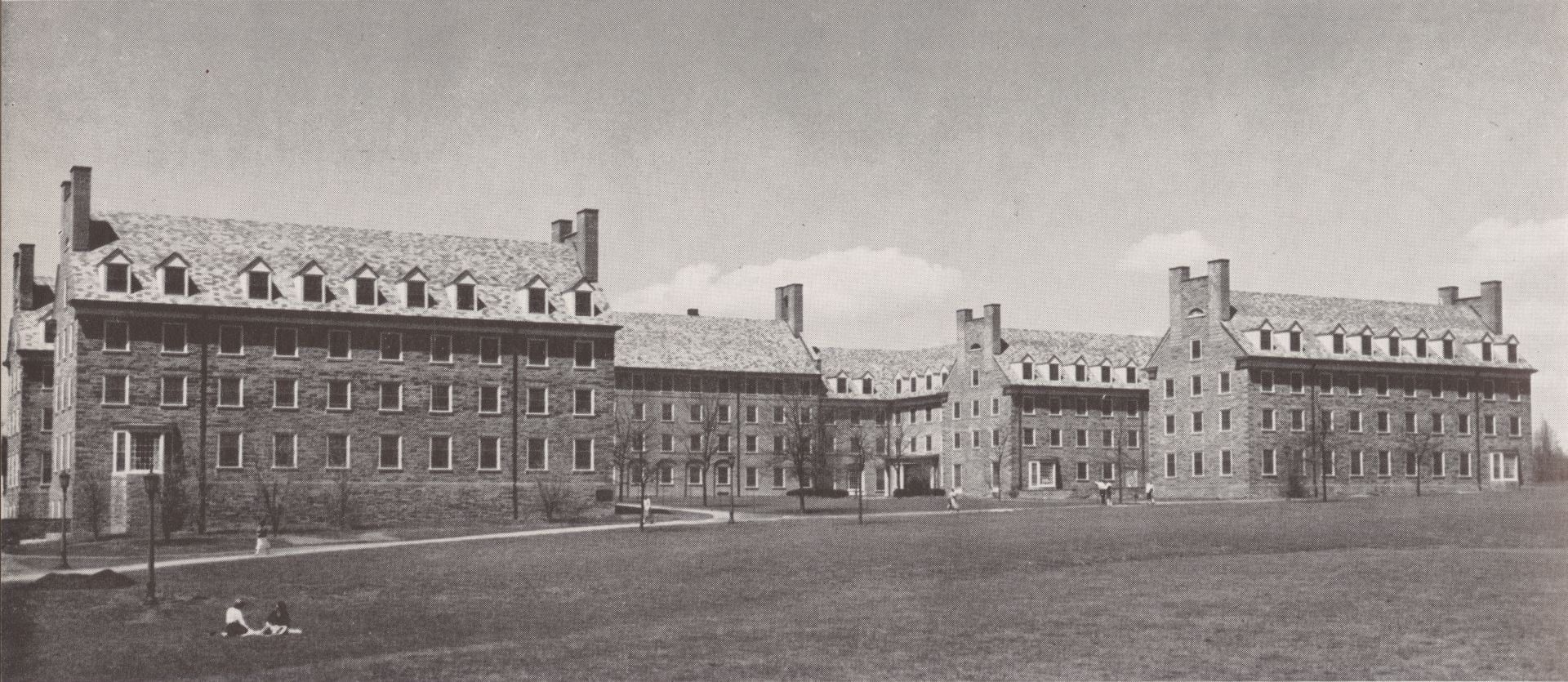
The Cornellian (1959), p. 274, top. Photograph of Clara Dickson Hall. University Archives. Division of Rare and Manuscript Collections, Cornell University Library. RMC2009_0180 (314011.0). https://digital.library.cornell.edu/catalog/ss:573758
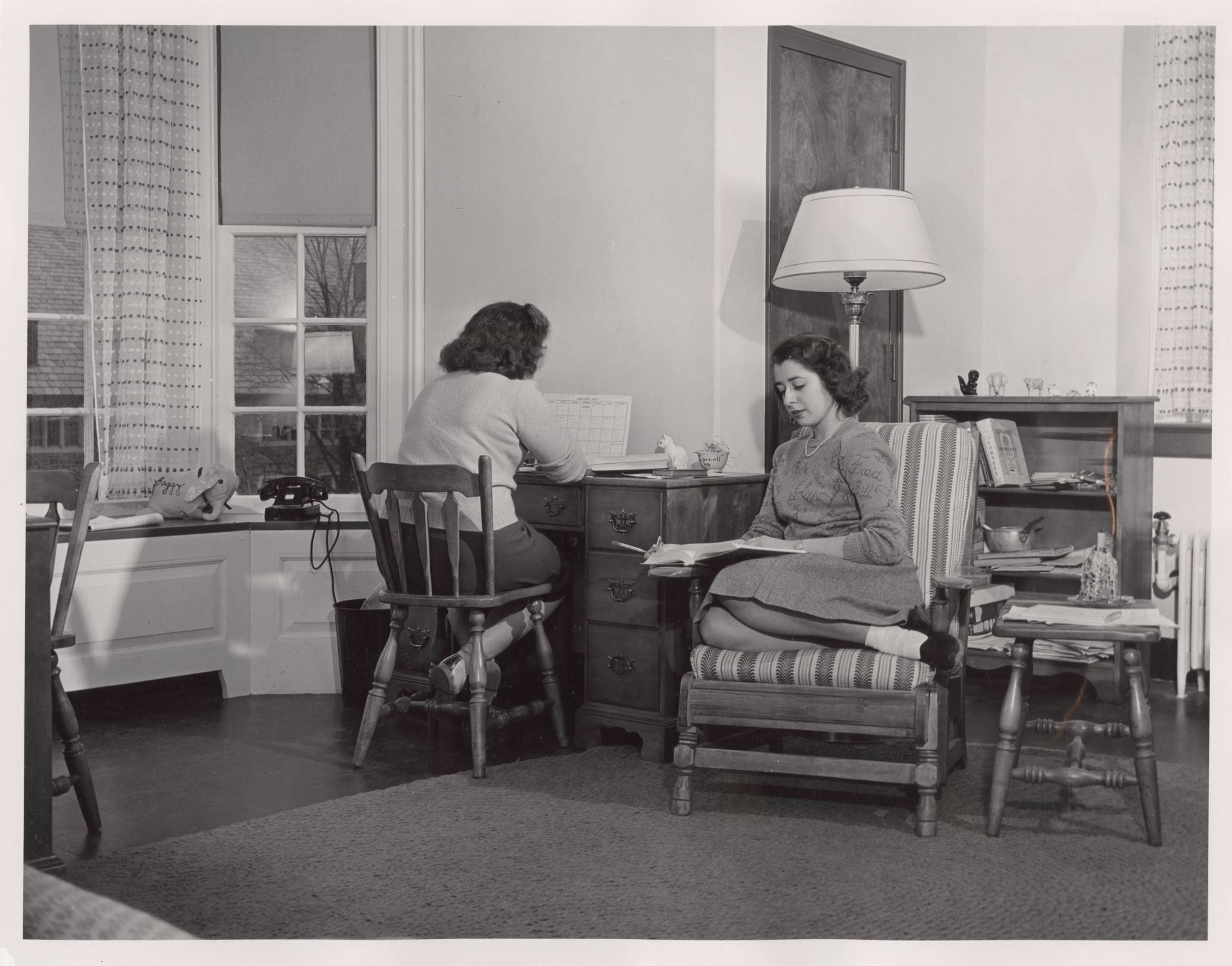
Cornell University (1955). Photograph of two female students in a Clara Dickson Hall dorm room. Archives picture collection, #13-6-2497. Division of Rare and Manuscript Collections, Cornell University Library. RMC2009_0186 (2089229). https://digital.library.cornell.edu/catalog/ss:573764
The M.R.S. Degree
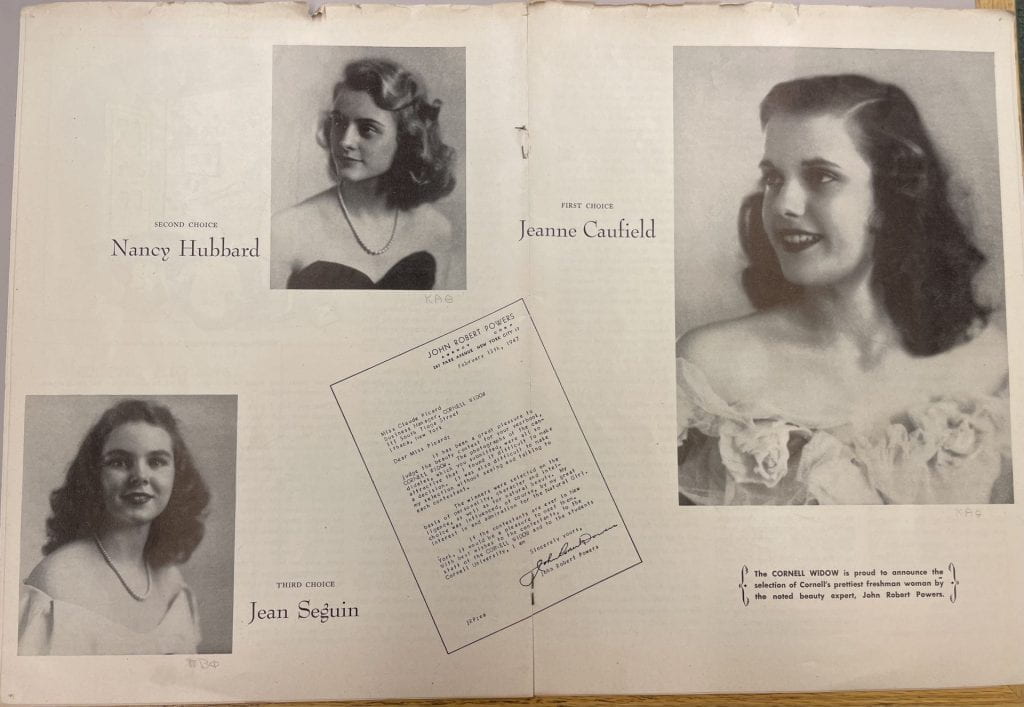
The 1947 issue of Cornell Widow featured photos of the “prettiest Cornell freshmen.” Cornell Widow was a student publication from 1894-1975. Class of 1950 Archives Project Papers, #41-4-4182 (box 1). Division of Rare and Manuscript Collections, Cornell University Library.
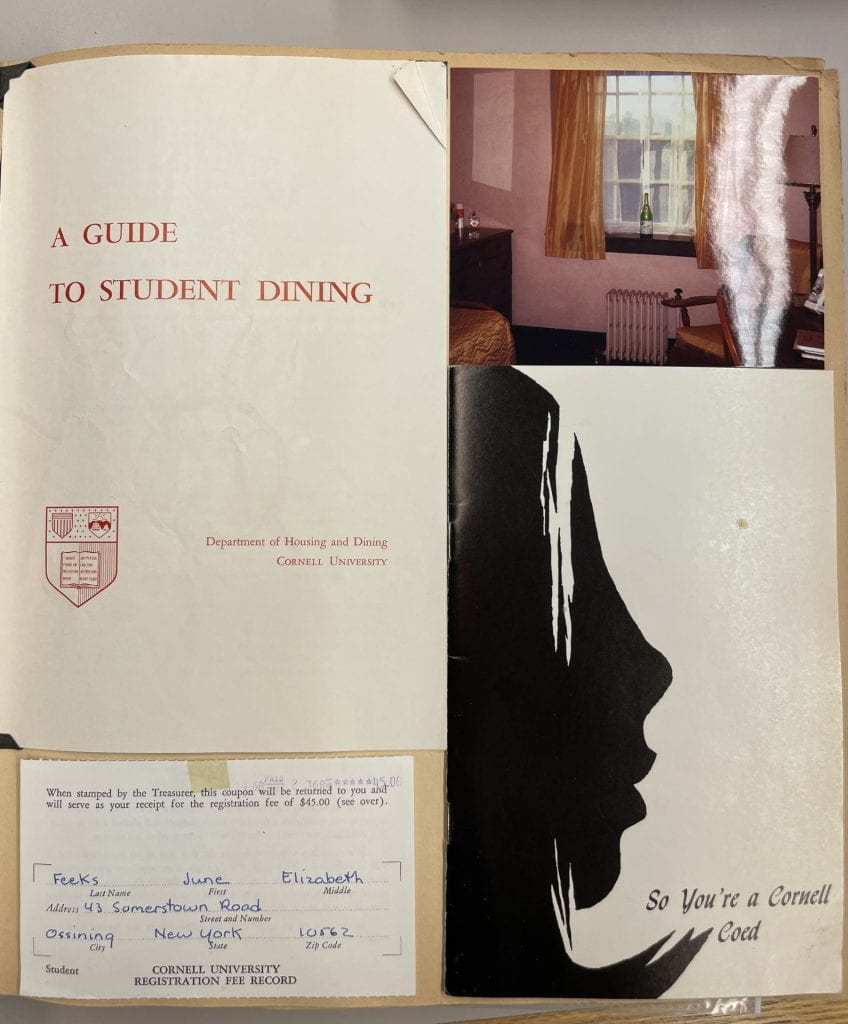
Excerpt from So You’re a Cornell Coed: Social Lifeˆ published sometime between 1968-1972. June F. Brooks Papers, #37-5-3886 (box 1). Division of Rare and Manuscript Collections, Cornell University Library.
In the 1960s, Cornell was conservative, white, and male-dominated. “It had been almost exclusively white when I got there and almost exclusively male,” Linda Barufaldi recalled, describing her impressions when she arrived in Ithaca in the fall of 1965. All women were required to wear skirts, until it became unbearable in the frosty wind of the Ithaca winter[4]. Treated as mere decoration to the glorious campus, women were expected to pursue a “MRS degree.” Barufaldi told us, “They said, ‘Where were you going to college?’ and I would say ‘Cornell,’ and they would say, ‘Oh, you will marry a rich man there.’” Barufaldi talked about people’s first reactions to her studying at Cornell, which revealed a common expectation for female college students at elite universities: find a rich man and get married[4].
Barufaldi remembered a protest she held with other students in front of the Registrar’s, an event for students in the 1960s to register for the new semester and enroll in classes. “We had some sign that says something about don’t be a sex object, and that this woman said, ‘That’s what I came to college for,’ and I wanted to smash my head on the table.”[4]
Five years later in 1970 when Jessica Bram entered college, the freshman register booklet that contained photos of all freshman women was referred as the “pig” book. “Because we were, you know, girls were pigs,” explained Bram[6]. Indeed, this booklet was used predominantly to invite attractive girls to fraternity parties. Similarly, Diana Petitti, ’71, said, “One of the things that I would say about Cornell at that time is if you were a female student, in some ways, you felt like you were prey.” Men would purposely get women drunk in the parties, and, “There was an element of predatory behavior among men, particularly in some of the fraternities.”[5]
Delta Chi Fraternity of Cornell University (1973). Delta Chi Spring Weekend May 1973. Delta Chi Fraternity (Cornell University) records, #37-4-734. Division of Rare and Manuscript Collections, Cornell University Library. RMC2015_0254 (2093704). https://digital.library.cornell.edu/catalog/ss:10193735
In the 1960s, Cornell was conservative, white, and male-dominated. “It had been almost exclusively white when I got there and almost exclusively male.”
Linda Barufaldi
When Petitti first stepped into Cornell, finding a good husband in college was the goal for most women in her class as there seemed to be few other options. “There was no support for women going into any career,” Petitti recalled, “You didn’t sit around in your dorm and say, ‘Where am I going to go to graduate school, or do I want to be a doctor or a lawyer, or what am I going to do after I graduate from Cornell?’ You sort of were left out there to say, ‘Well, what am I going to do with my bachelor’s degree other than get married?’”[5] While female students could theoretically major in any subject they desired, there was no career counseling for women at all. The only prospect the university held for these women was to become future respectable wives, a career requiring no counseling and no guidance from their perspective.
Changes
Shortly after the Willard Straight Hall takeover in 1969, protests against racial discrimination, along with the antiwar movement that had heated up nationwide, quickly transformed Cornell. “It changed for women, because it began to be recognized that women were in college for reasons other than to find a husband, and there became opportunities for women that were not there before,” said Petitti[5]. Professional schools and graduate schools started to take more female students. The College of Home Economics was renamed as College of Human Ecology in 1969[8], expanding its role from educating future wives to introducing students to greater possibilities. When Bram enrolled in 1970, “It was definitely a feminist tone…you know you’re going to have a career, and it was my friends… apply for law school or med school. There was no question of that.”[6]
In a matter of years, Bram experienced a changed set of horizons beyond a future household, different from the expectations experienced by Barufaldi and Petitti, both of whom had already finished their undergraduate degrees at Cornell. Petitti, who was supposed to graduate in 1971, completed her requirements early and eventually became a medical doctor and epidemiologist specializing in women’s health broadly conceived. Jessica Bram became a writer. And Linda Barufaldi became a feminist activist and scholar.
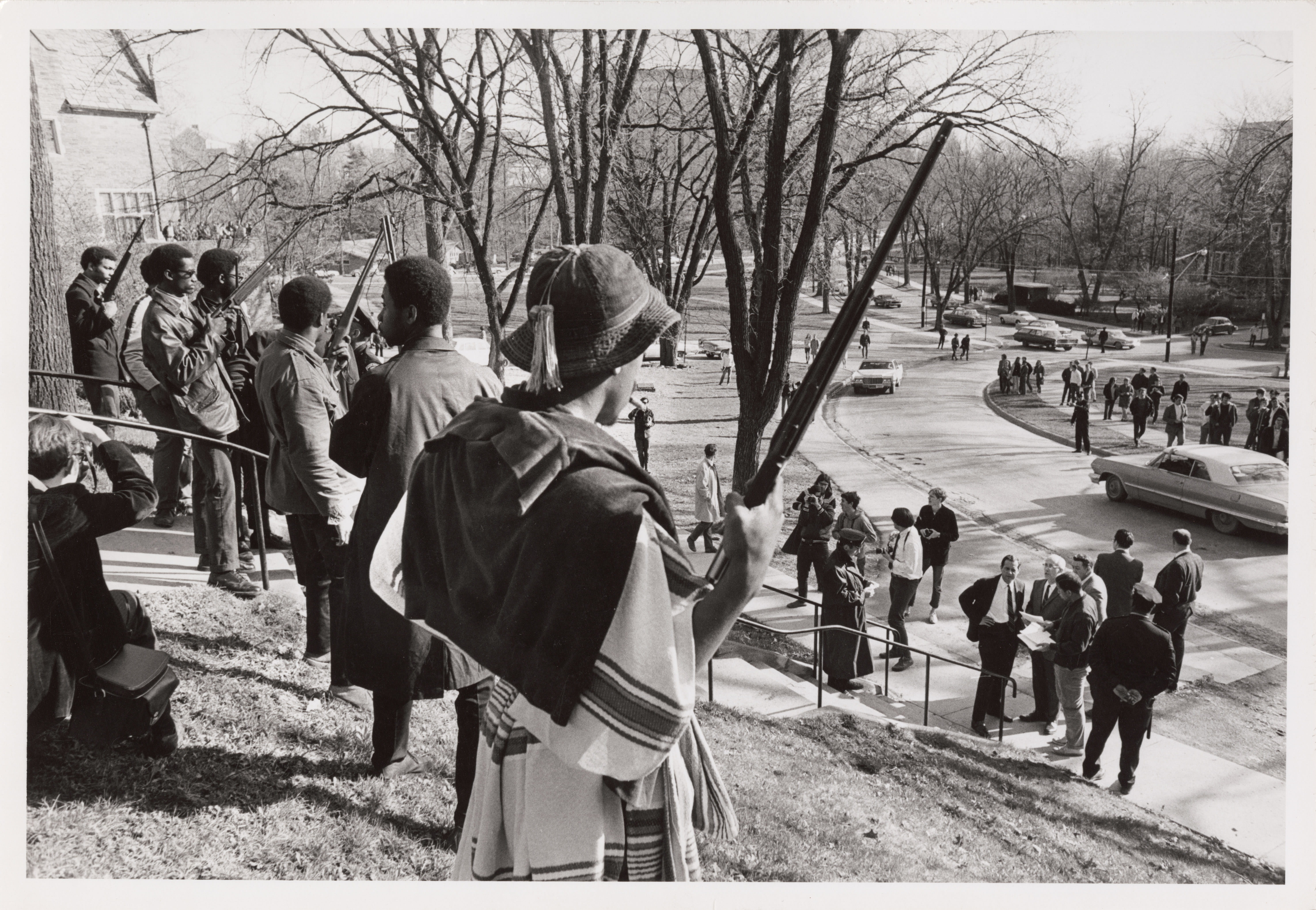
Cornell University, Office of Visual Services (1969). Willard Straight takeover agreement 320 Wait Avenue. Office of Visual Services photographs, #4-3-2093. Division of Rare and Manuscript Collections, Cornell University Library. RMC2013_0140 (2077875). https://digital.library.cornell.edu/catalog/ss:1312602
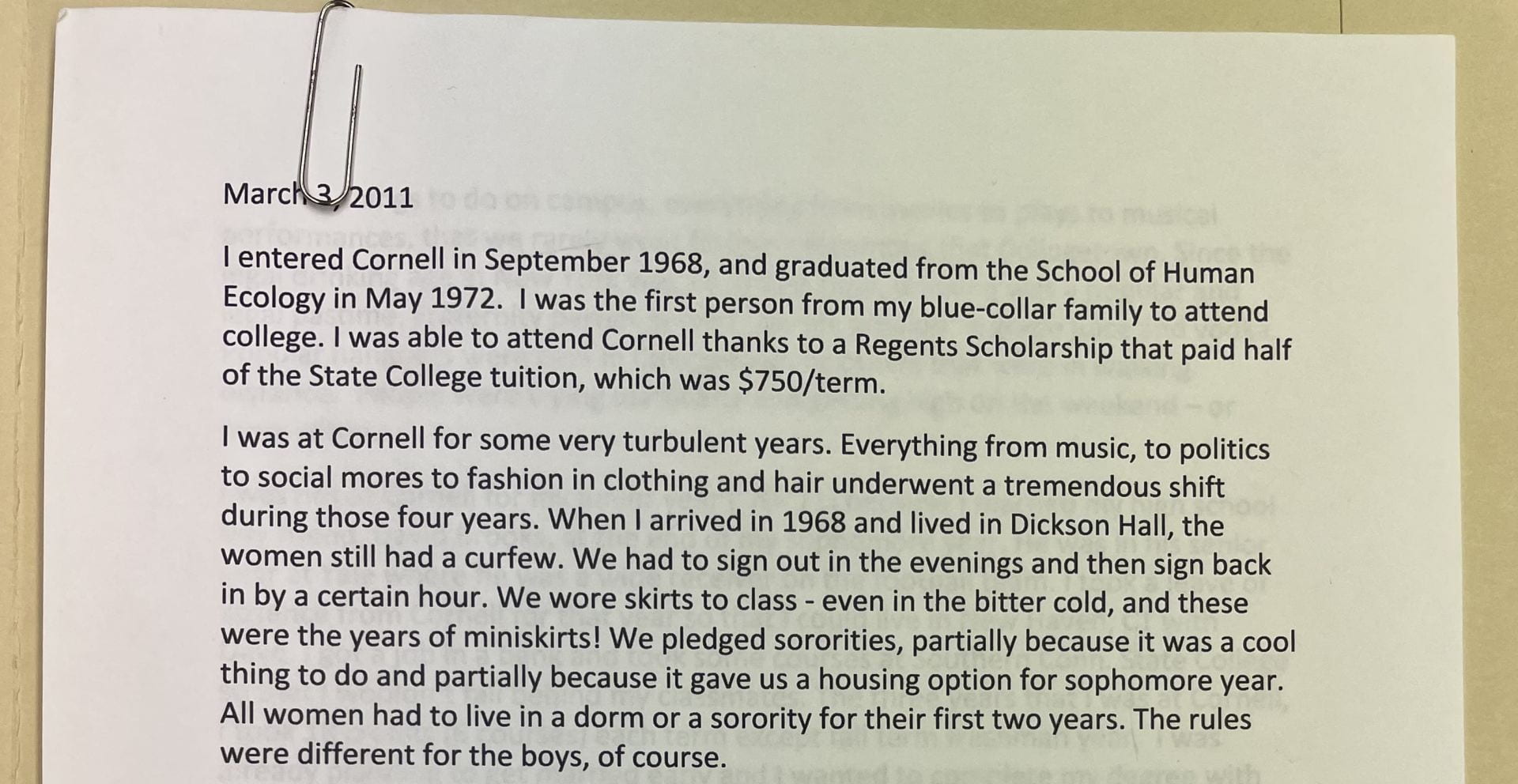
Women’s Self Government Association (1922). Some Things Not Counting as Nights Out. https://rmc.library.cornell.edu/cornell150/exhibition/sexcolor/index.html
After the court case Dixon vs. Alabama in 1961, which ruled that universities could not paternalistically act in loco parentis to discipline students, curfew was challenged in many colleges nationwide. The Women Self-Government Association (WSGA) of Cornell eventually lifted the curfew for female students in 19691. Student feminist organizing and activism spurred the policy changes to which they were legally entitled.
Big Red Sex Ed
No Sex on Campus (or “Nice Girls Don’t F*ck”)
While sex has always been a part of college life in any era, knowledge about reproductive health has been very much less so. In the 1960s, the idea of virginity still prevailed on campus and in society. One alumna with whom we casually spoke said it plainly: “Nice girls don’t f*ck, you know.” Barufaldi, remembering that biased standard that people once agreed to, said, “No nice professional upstanding man would want to marry a woman who was not a virgin, even though of course he wouldn’t be a virgin.” However, “I’m not saying we weren’t all doing it (sex), I’m saying that no one admitted to doing so.”[4] Even the university chose to remain silent on this topic; as Petitti recalled, “The administration seemed to think that if you didn’t talk about sex, it wasn’t happening.”[5] As the sole prospect for female college students in the eyes of the university and society was to become respectable housewives who conform to patriarchal expectations, the administration was reluctant to acknowledge the need for sex education, as that would suggest some “stigma of impurity” among Cornell women.
Without internet or any reliable resources to turn to, young men and women were there to explore a realm that they had little knowledge of on their own. Barufaldi recalled her encounter with a pregnant girl who didn’t believe “you could get it the first time.”[4] Despite the fact that she and her peers were receiving one of the best educations in the country, they knew little about their bodies and were left vulnerable when things happened.
“The administration seemed to think that if you didn’t talk about sex, it wasn’t happening.”
“Out of anger and irritation at the administration for their failure to provide women with any kind of information that would allow them to interact meaningfully in a sexualized environment,”[5] explained Petitti, she, Barufaldi, and another student, Judy Gladnick, worked together with Planned Parenthood on a sex education pamphlet that was to be distributed among students in 1970[9].The pamphlet carefully described various kinds of contraception saying, “It is much easier and less painful to prevent conception than to obtain an abortion, force a marriage, or have a child out of wedlock.” Pregnancy and options that women in Ithaca had were also discussed, as well as sexually-transmitted diseases (STDs)[9]. The cover of the pamphlet was purposely left without a name, and the birds and bees’ motif was to make it look like a clip art book, which were common at that time[4],[5]. In this way, students could carry the book around without being seen needing information about sex. Notably, Alpha Phi Omega fraternity was responsible for the cost of printing for that pamphlet[9]. While the administration did not provide any help, just as people turned a deaf ear to the fact that sex existed on campus, no pushback occurred in relation to this this much-needed information[4],[5].
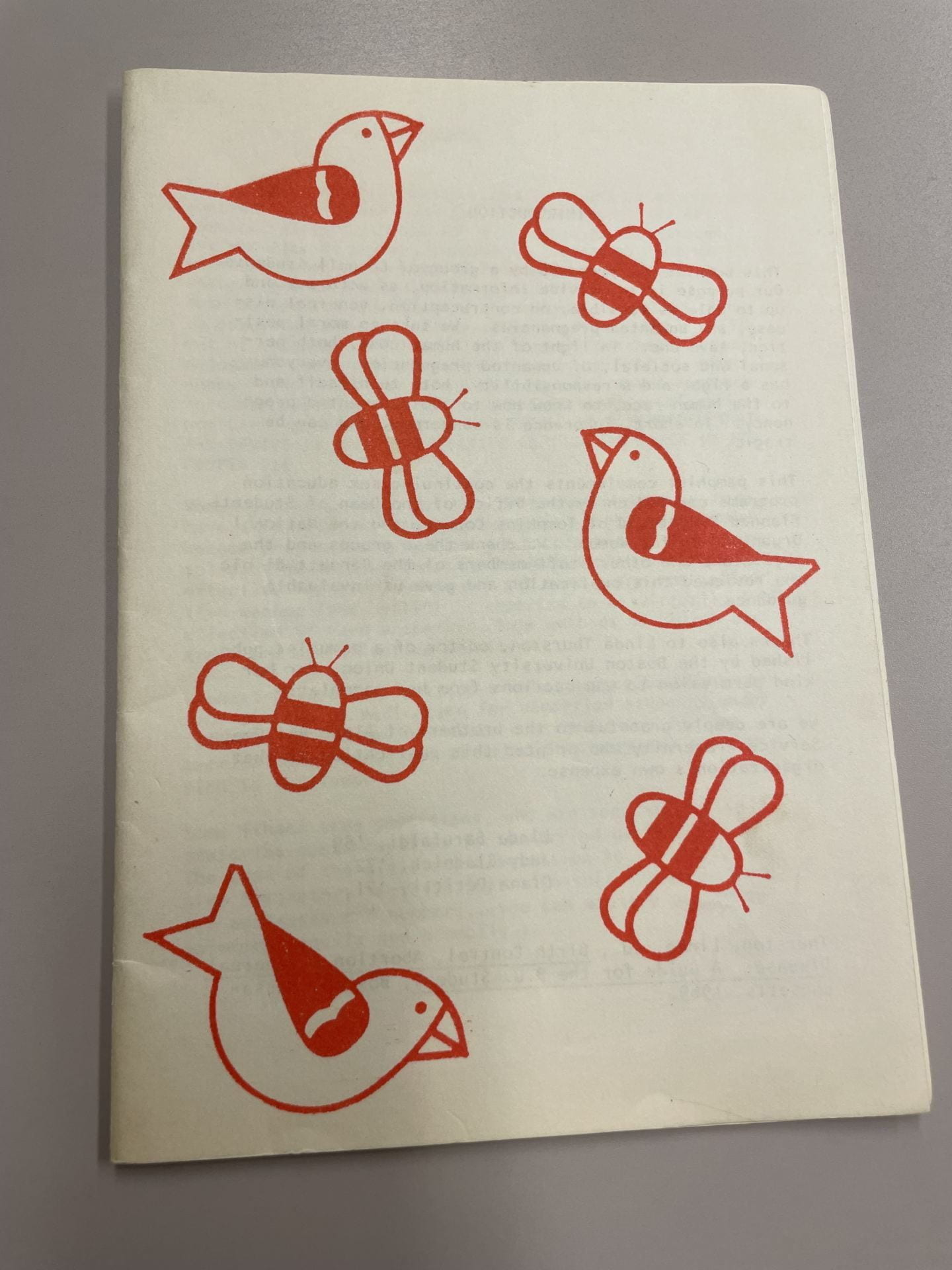
Mei and Parreñas (2022). No Name Pamphlet Cover. Cornell University Contraception, Gynecology and Sexuality Service Records, #51-1-2511 (folder 1). Division of Rare and Manuscript Collections, Cornell University Library.
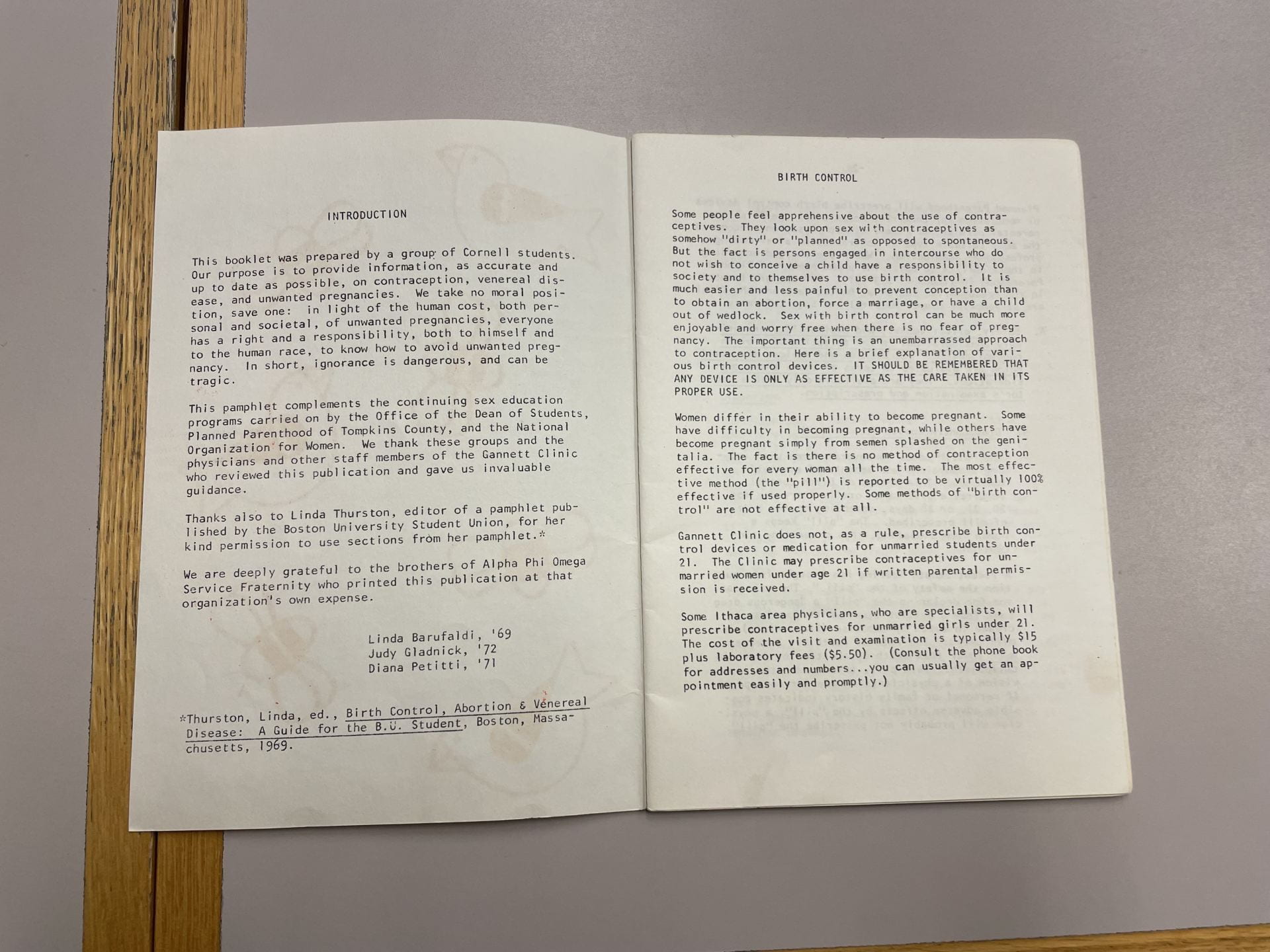
Mei and Parreñas (2022). No Name Pamphlet First Page. Cornell University Contraception, Gynecology and Sexuality Service Records, #51-1-2511 (folder 1). Division of Rare and Manuscript Collections, Cornell University Library.
Institutional Involvement
Shortly after the appearance of the first sex education pamphlet, which coincided with changes in society’s expectations for female college students as connoted by swelling national support for the passage of Title IX, Cornell started to value the importance of sex education. Sex: Beyond Birds and Bees, a revision on the previous unnamed pamphlet, was prepared by the Sex Education Committee and Sex Education by and for Cornell Students (SECS), a year after the first publication[9]. In her capacity as a sex counselor for Gannett Health Services, Rosalind (Roz) Kenworthy prepared another two versions of Sex Information in 1972 and 1973, with funds from the Office of the Dean of Students and SECS[9]. While SECS was not a well-known student organization at that time, as recalled by several alumni[4],[5],[6], it appeared to be active in promoting sex education on campus.
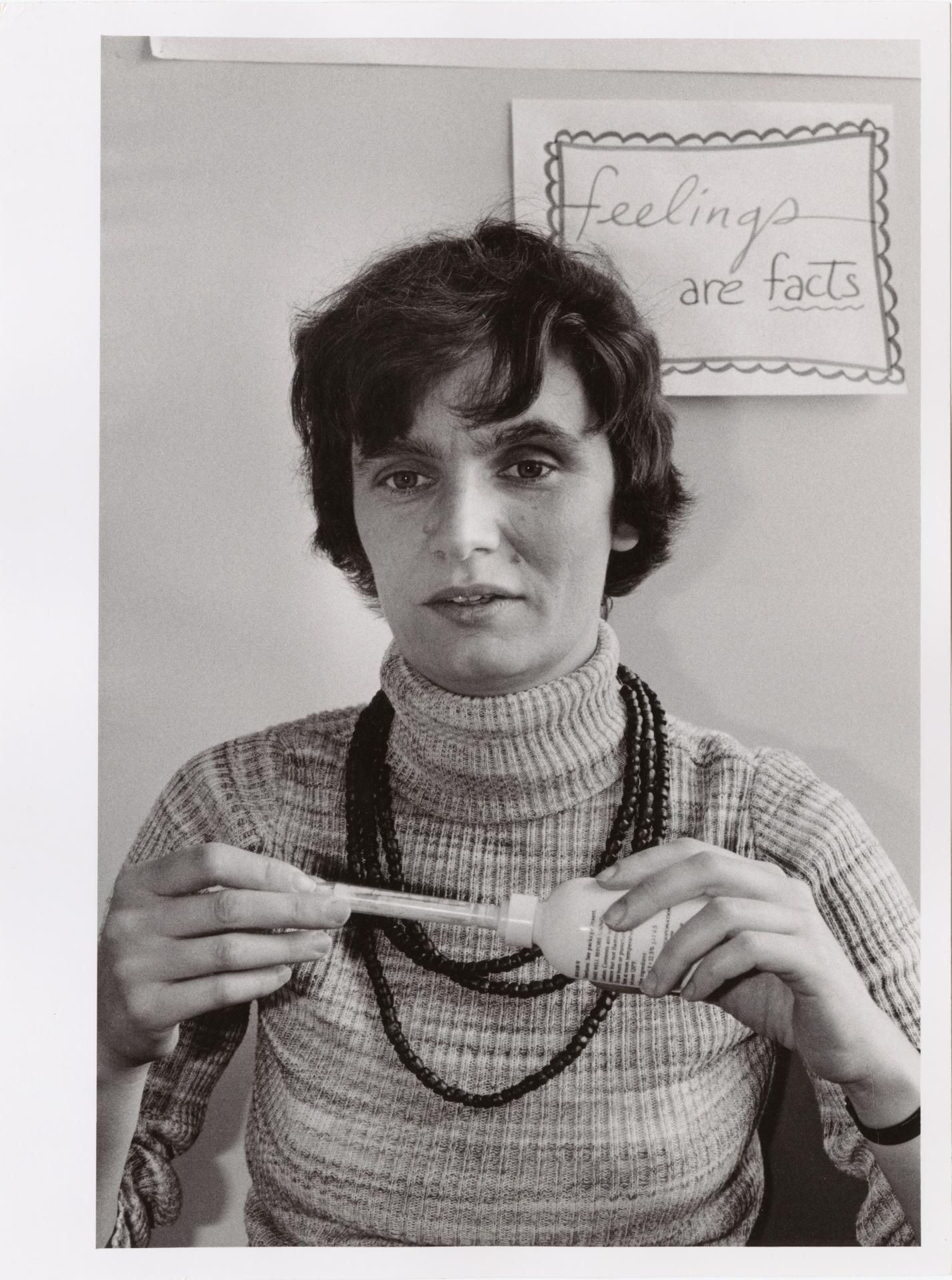
Cornell University (1973). Rosalind (Roz) Kenworthy, CGSS at Gannett. Cornell University News Service records, #4-3-15. Division of Rare and Manuscript Collections, Cornell University Library. RMC2006_0793 (2073562). https://digital.library.cornell.edu/catalog/ss:548443
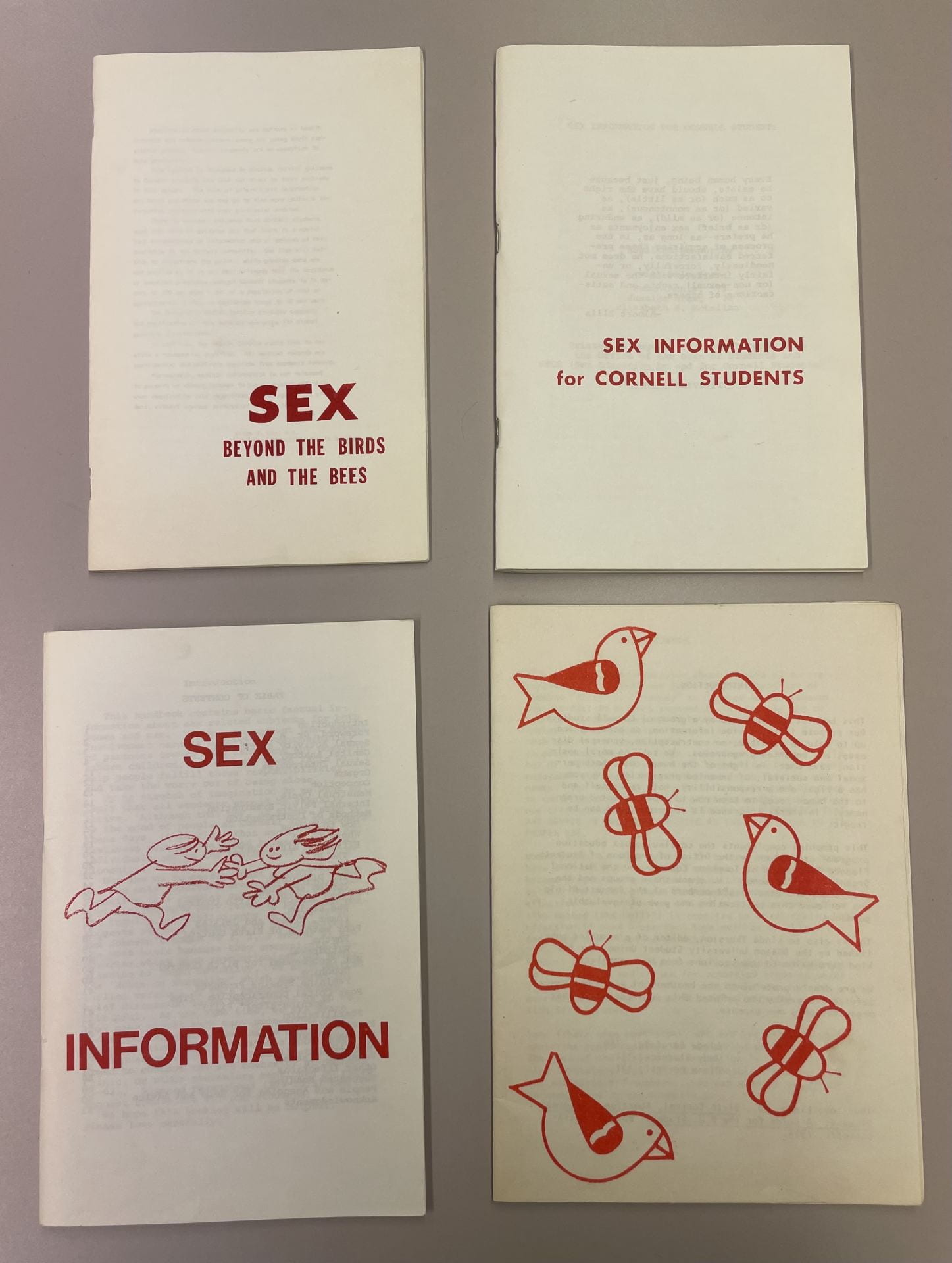
Mei and Parreñas (2022). Sex Ed Pamphlets Cover. Cornell University Contraception, Gynecology and Sexuality Service Records, #51-1-2511 (folder 1). Division of Rare and Manuscript Collections, Cornell University Library.
The sex ed pamphlets authored by Roz Kenworthy quickly became a model among universities across the United States. With the hope of using it directly or as a reference in their own versions of sex education booklets, a number of student health services programs wrote letters to request copies of her pamphlets[10]. A letter from Roz Kenworthy suggested that, “Two thirds (of Cornell students) have read the booklet, 90% thought such a handbook should be available.”[10] On the other hand, some parents expressed their concerns regarding the booklet in their communication with university President Frank H.T. Rhodes, who reassured these parents that, “The object of the book is to help all students to lead responsible lives on the campus.”
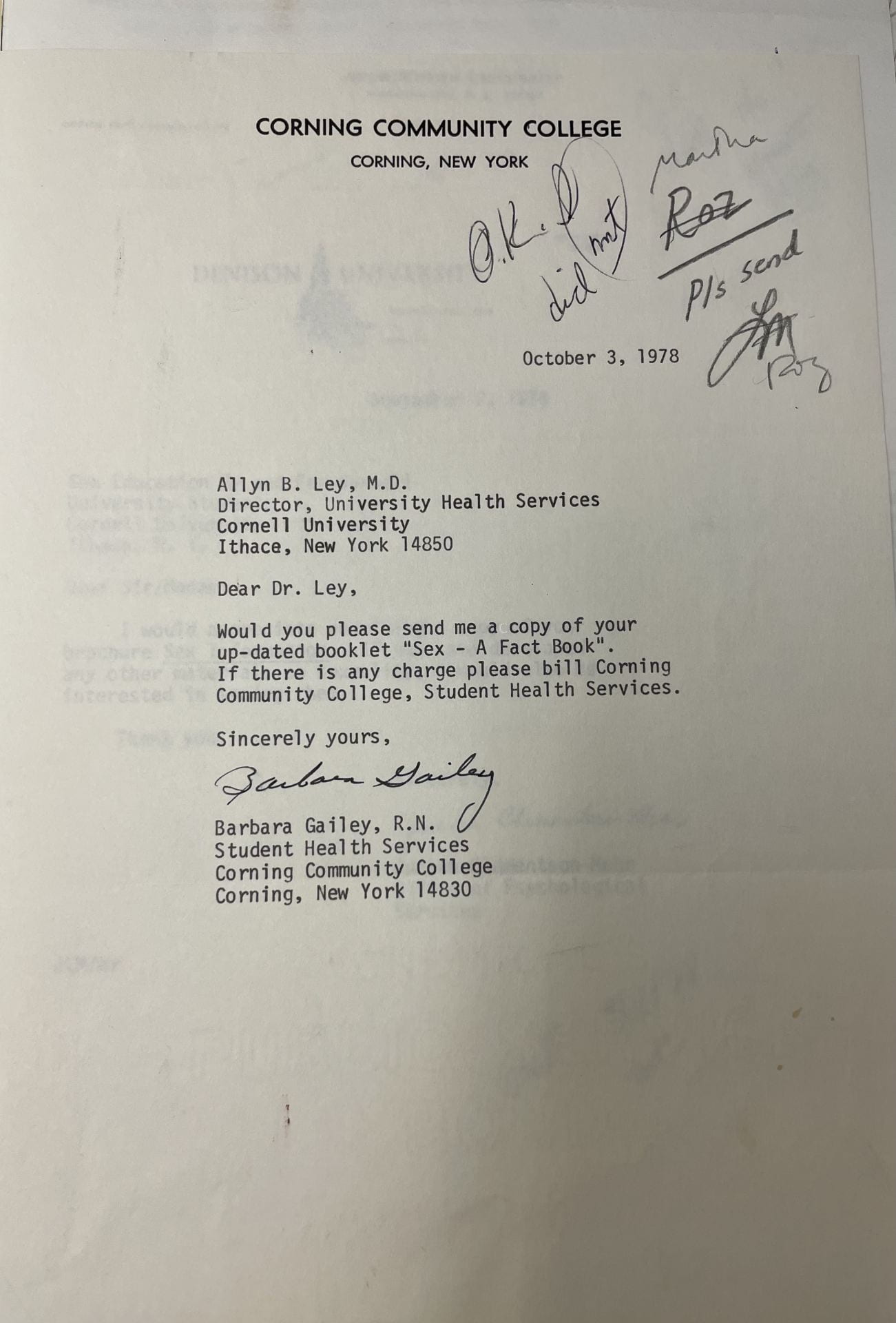
Mei and Parreñas (2022). Letter from Corning Community College Student Health Services. Rosalind Kenworthy Papers, #7731. Division of Rare and Manuscript Collections, Cornell University Library.
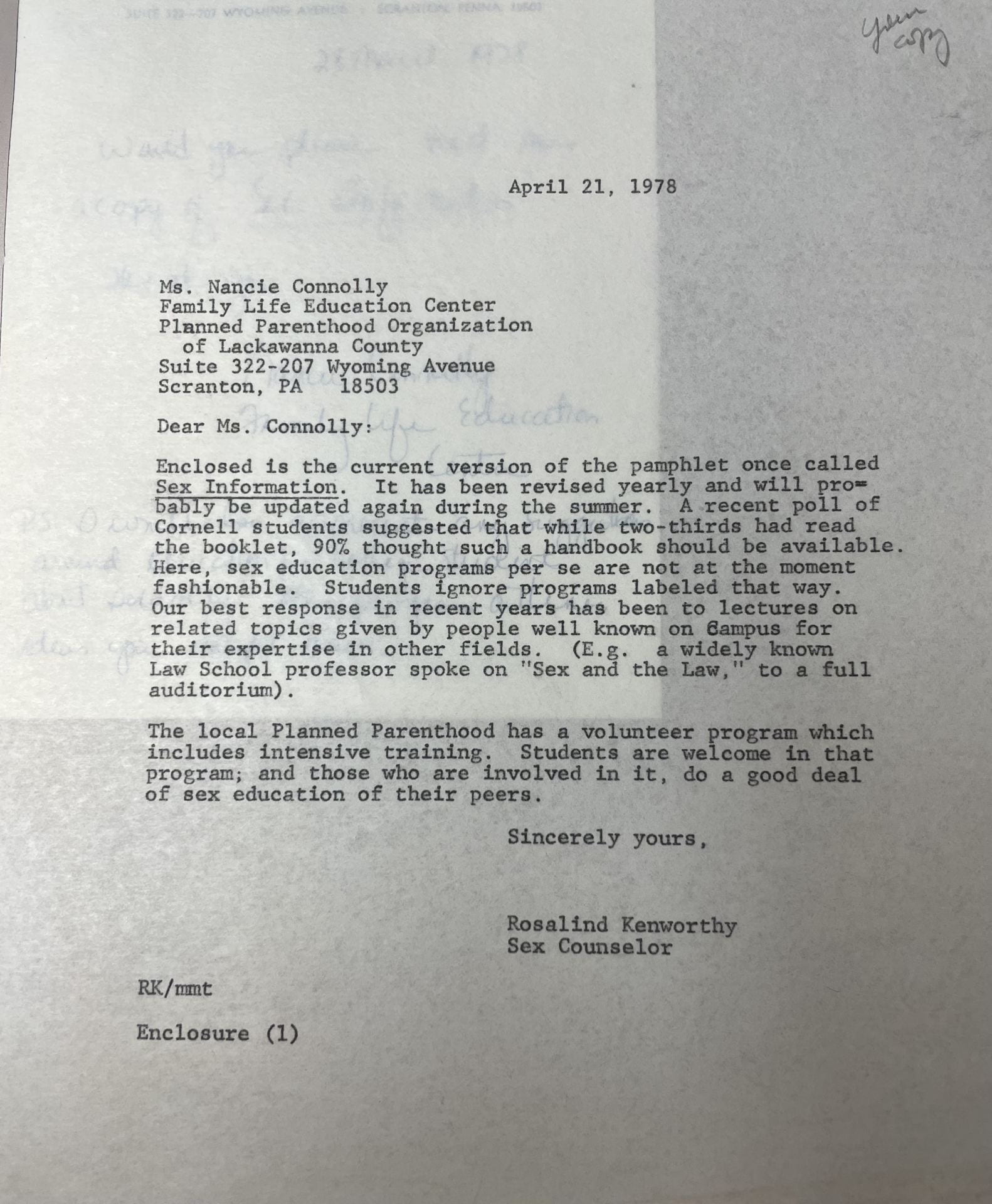
Mei and Parreñas (2022). Reception of Sex Information pamphlet. Rosalind Kenworthy Papers, #7731. Division of Rare and Manuscript Collections, Cornell University Library.
Sex Counseling
The Planned Parenthood of Tompkins Country cooperated with Cornell University in 1970 to open a clinic at the Sage Infirmary on Seneca Street that would provide “birth control services and information for students and the general public.” [9],[10] One year later, Roz Kenworthy was appointed as the first sex counselor in the country[10]. While unclear when it started or where it took place, sex counseling services led by Kenworthy were active in the late 1970s, and she advised students about birth control, abortion, venereal diseases (now known as Sexually Transmitted Infections or STIs), and general reproductive health information[11]. The objectives of sex counselors were: “to be the source of accurate factual information, to make appropriate referrals and to respond sensitively and relevantly to the needs of the individual clients.” For the first time, students had a place to talk about their confusions over birth control, sexuality, or what they feared was excess masturbation[11].
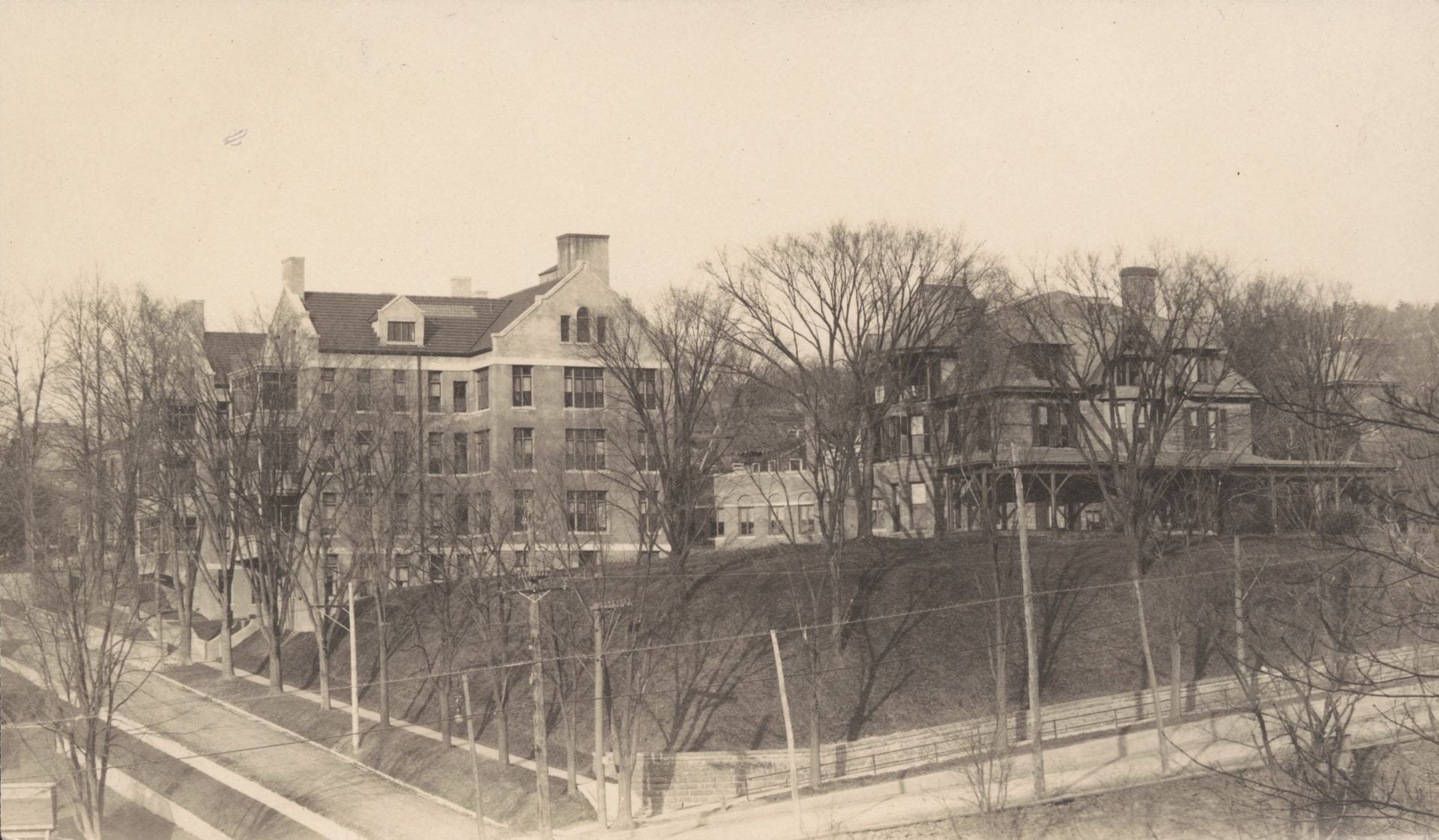
Cornell University Library, Cornell University Archives. Sage Infirmary. Archives picture collection, #13-6-2497. Division of Rare and Manuscript Collections, Cornell University Library. RMC2010_0284 (2089229). https://digital.library.cornell.edu/catalog/ss:574326
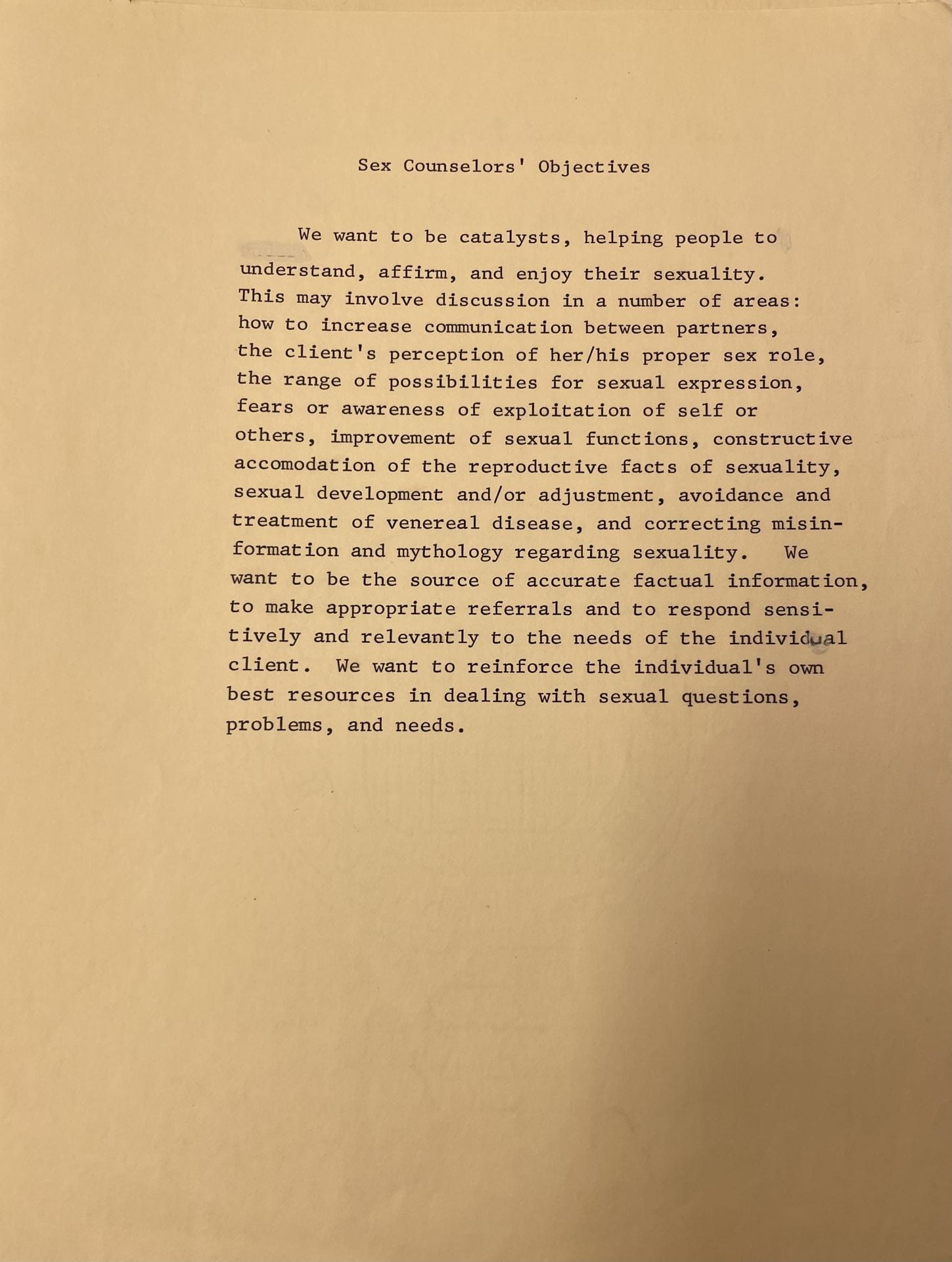
Mei and Parreñas (2022). Sex Counselors’ Objectives. Cornell University Contraception, Gynecology and Sexuality Service Records, #51-1-2511 (folder 2). Division of Rare and Manuscript Collections, Cornell University Library.
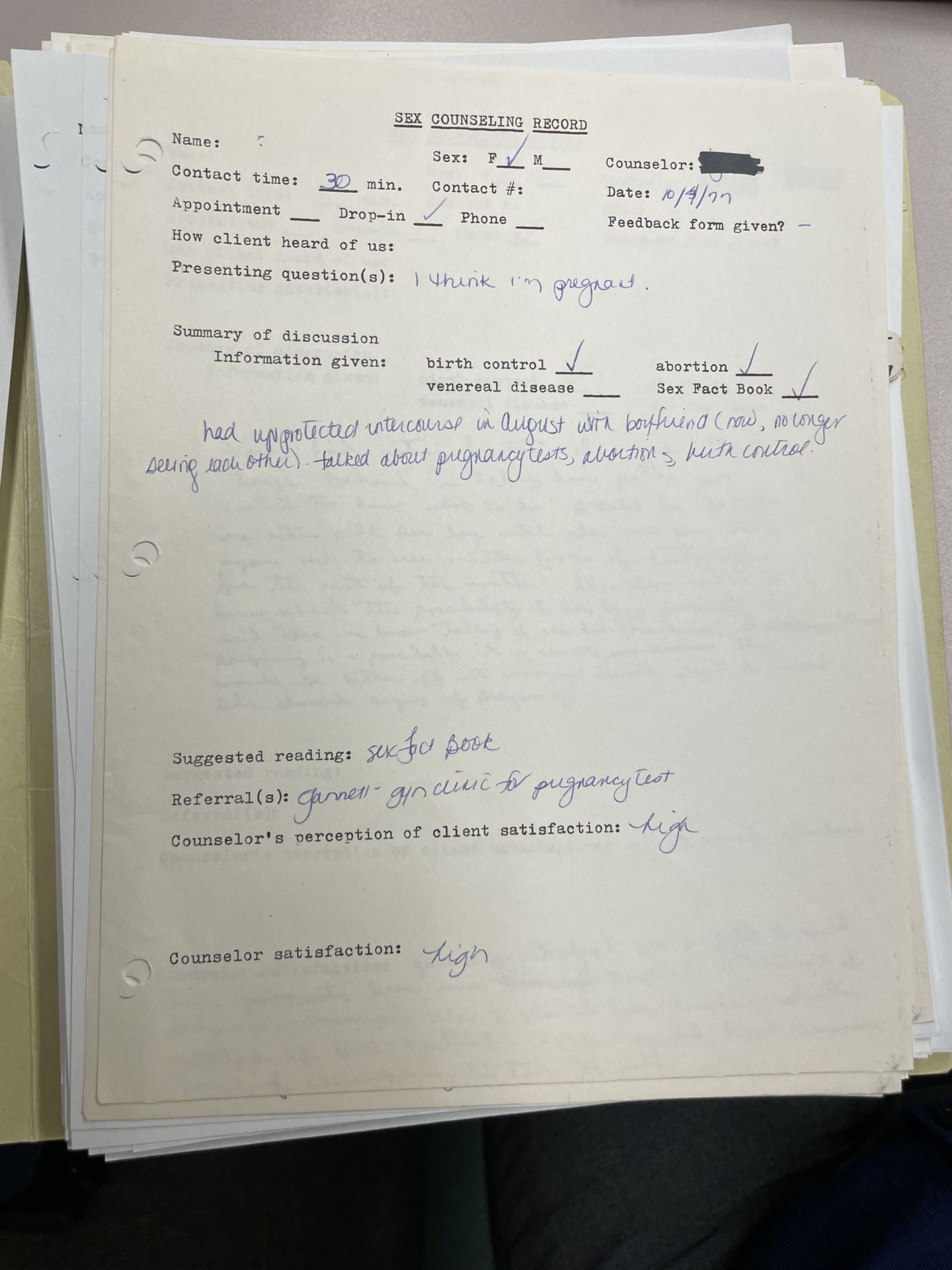
Mei and Parreñas (2022). Sex Counseling record 1. Cornell University Contraception, Gynecology and Sexuality Service Records, #51-1-2511 (folder 3). Division of Rare and Manuscript Collections, Cornell University Library.
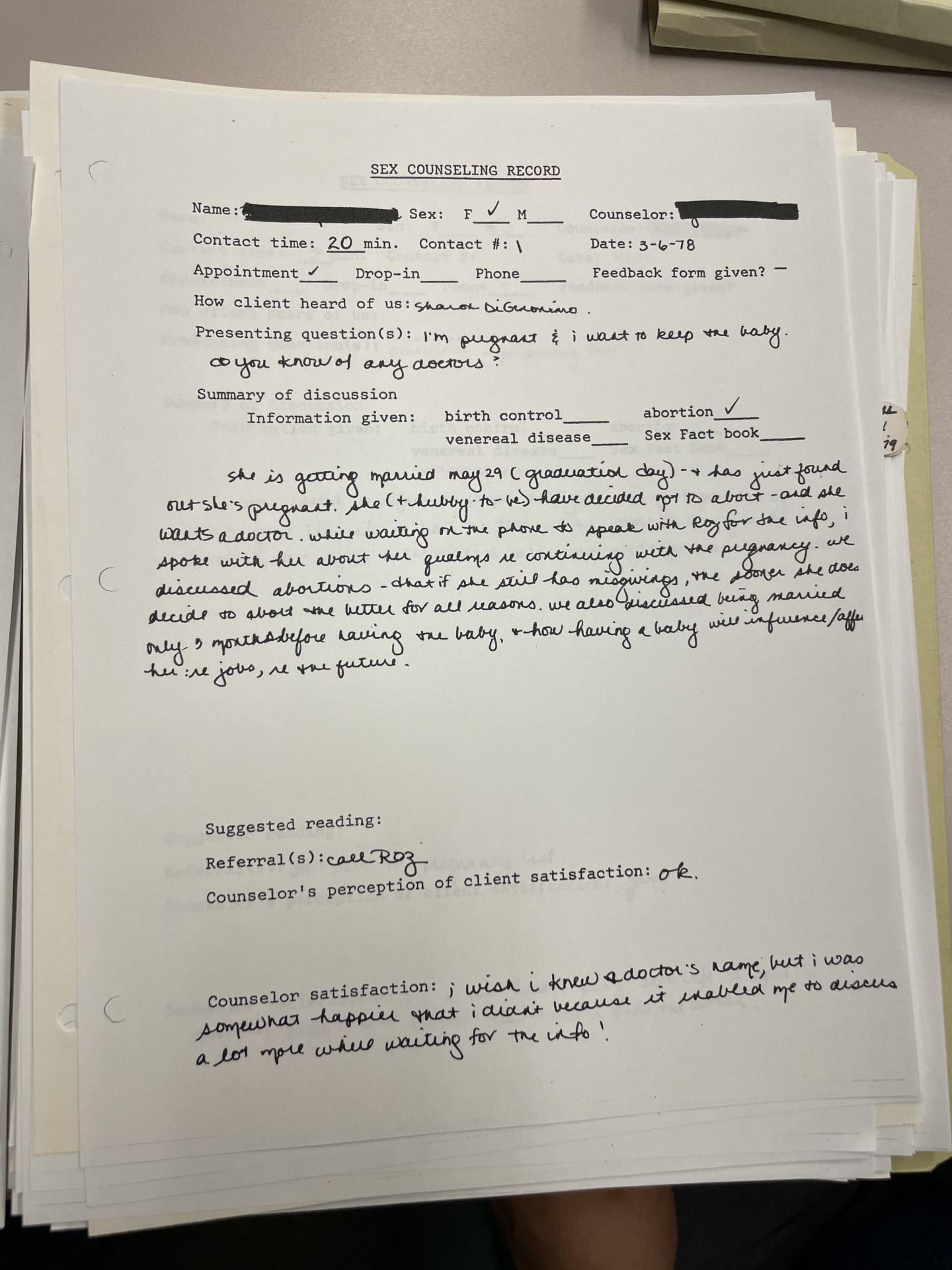
Mei and Parreñas (2022). Sex Counseling record 2. Cornell University Contraception, Gynecology and Sexuality Service Records, #51-1-2511 (folder 3). Division of Rare and Manuscript Collections, Cornell University Library.
While it is unclear when it ended or why it ended, sex counseling is no longer an individual service on campus. Cornell Health provides sexual health care across a range of services, including contraception, pregnancy testing, STI testing, and transgender services, and appointments are to be made like all other medical appointments over the phone during business hours[12]. Unlike women in the 1960s, current students enjoy the convenience of the internet, but counseling and guidance over reproductive health remains crucial as misinformation could pose further risks to students’ health.
Abortion
New York decriminalized abortion up to the 24th-week of pregnancy in 1970,[13] before Roe vs. Wade in 1973. Without proper contraception or access to abortion, college women could not control their own reproductive health, being “at the mercy of choosing between never having sex or having sex, getting pregnant, and ending up married or with a baby that you couldn’t support,”[5] as Petitti put it.
Without proper contraception or access to abortion, college women could not control their own reproductive health…
The Clergy Network
Prior to the legalization of abortion in New York, Barufaldi worked for a network of women and clergies that supported pregnant women in seeking the abortion they desired. They would check the condition of the fetus to see if legal abortion were possible, take women to a state where abortion was legal, or refer them to a doctor who was willing to perform the procedure. To minimize the risks for the women and persons involved, anonymity was strictly maintained for all parties within the network: “You only knew the name of the person to whom you were going to refer the woman, and you didn’t know how she got to you,” said Barufaldi. The person Barufaldi would refer the women to was a Catholic priest in Cornell United Religious Work (CURW), and he sometimes drove them all the way to Pennsylvania to doctors who were willing to do it[4]. Prior to legal abortions, women could still figure out a way to do it with the help of the network, but they faced financial burdens and the risks of unsafe procedures.
Planned Parenthood
While abortion became legal in 1970, access remained a problem for many Cornell women. Gannett Clinic, Cornell student health services at that time, did not provide contraceptives nor did they offer abortion to unmarried women under the age of 21 without written permission from parents[5],[9]. “It was as if they were pretending that you needed to have your parents’ permission to have sex, and there was no regulation whatever of the fraternities and all the things that happened in fraternities,”[5] Petitti shared. Obstacles in getting help from the Gannett Clinic to manage their reproductive health left young women at Cornell with no other options but local clinics and Planned Parenthood, which were both physically located far away from campus. With female students required to live on campus and have no cars, they were forced to rely on men who had a car: “[You would] have your fraternity person or somebody who lived off campus drive you to Planned Parenthood,”[5]said Petitti.
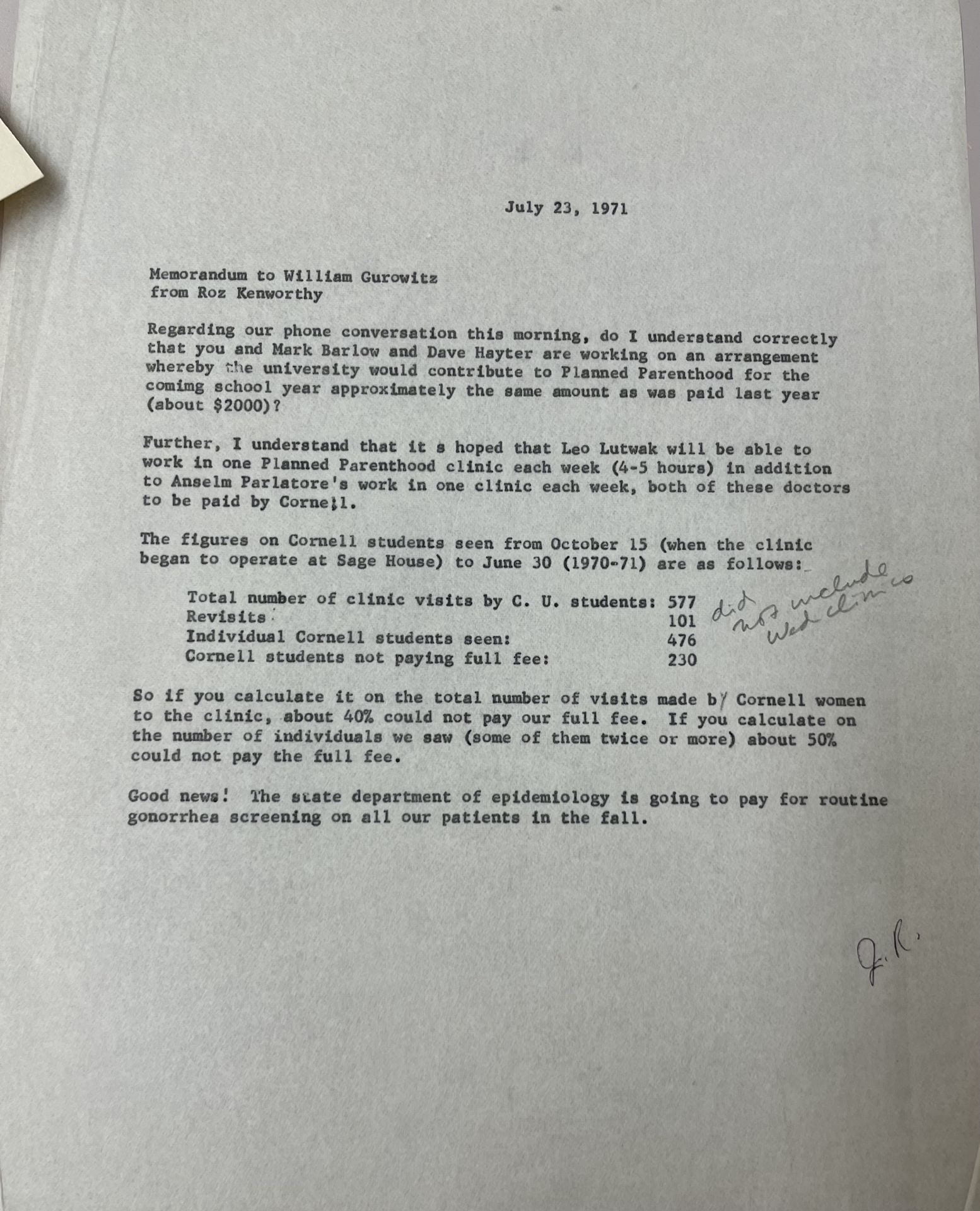
Mei and Parreñas (2022). Memorandum to William Gurowitz from Roz Kenworthy. Cornell University Contraception, Gynecology and Sexuality Service Records, #51-1-2511 (folder 2). Division of Rare and Manuscript Collections, Cornell University Library.
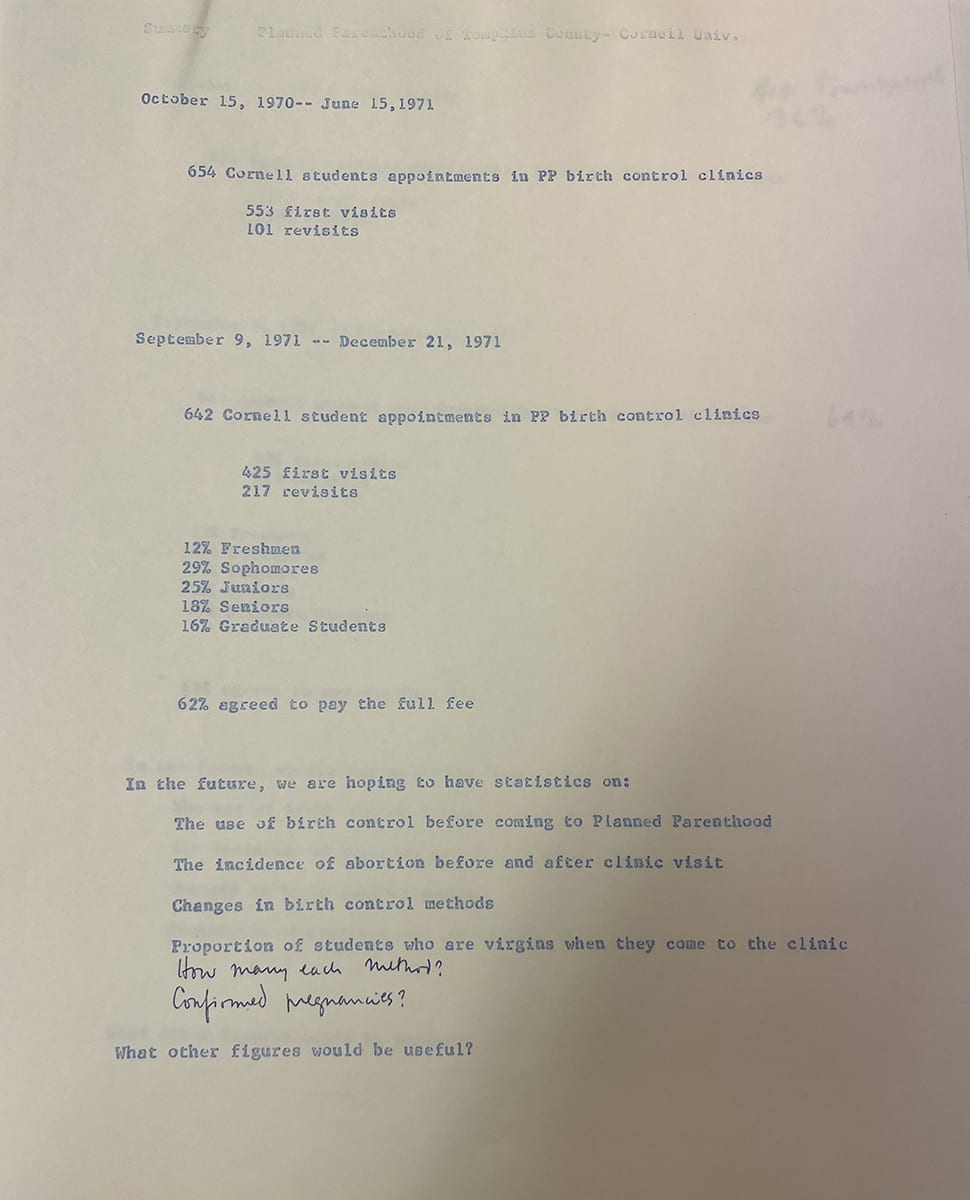
Mei and Parreñas (2022). Statistics about Cornell students’ visits to Planned Parenthood clinics. Cornell University Contraception, Gynecology and Sexuality Service Records, #51-1-2511 (folder 2). Division of Rare and Manuscript Collections, Cornell University Library.
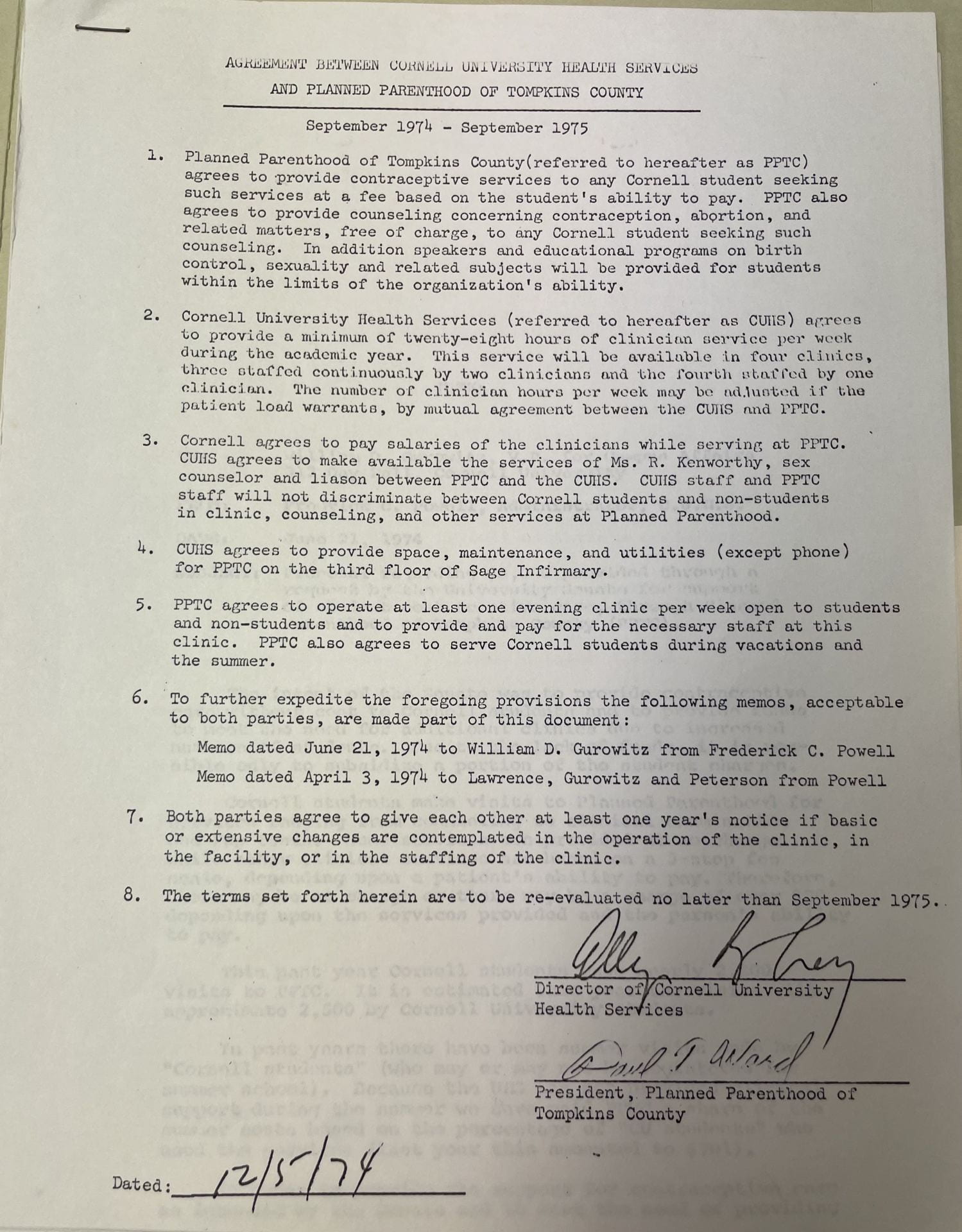
Mei and Parreñas (2022). Agreement between Cornell University Health Services and Planned Parenthood of Tompkins County. Cornell University Contraception, Gynecology and Sexuality Service Records, #51-1-2511 (folder 2). Division of Rare and Manuscript Collections, Cornell University Library.
Another barrier women would face was the cost of service off campus. For Ithaca area physicians, “the cost of visit and examination is typically $15 plus laboratory fees ($5.50),”[9] which was approximately 155.23 dollars for each appointment in today’s value[14]. Planned Parenthood of Tompkins County would “recommend the most suitable type of contraception after making a professional examination,” and “women are charged according to their ability to pay.”[9] However, one year after the clinic at the Sage Infirmary opened, Planned Parenthood was overwhelmed with Cornell students who could not afford the full price. Communication between Roz Kenworthy and Planned Parenthood mentioned that “about 40% (of Cornell women to the clinic) could not pay our full fee,” and, “if you calculate on the number of individuals we saw (some of them twice or more) about 50% could not pay the full fee.”[10],[11] Eventually, the university agreed to subsidize Planned Parenthood, contributing 2,000 dollars annually so that it could continue its services for Cornell women[12].
Present Day Crisis
Fifty years later, current students can seek referrals from Cornell Health located on the Ho Plaza. Cornell Health will “provide education about your options, based on how far your pregnancy has progressed, and help you manage the logistics of scheduling a procedure in Ithaca or at another location of choice.”[15]
Contraception and abortion enabled a generation of young people to pursue their aspirations. Indeed, both were vital in supporting educational goals for women. For women like Jess Bram, Diana Petitti, and Linda Barufaldi, unwanted pregnancy would have meant dropping out of college or resorting to life-threatening, poorly administered back-alley abortions. Cornell understood that in the 1970s, and literally supported the endeavors of healthcare providers who could carry out abortion procedures. Now, in 2022 and beyond, as the Dobbs vs. Mississippi Supreme Court ruling enables states to force unwanted pregnancies and childbirth and end access to abortion, knowing that pregnancy and childbirth would seriously threaten success in education, what role will universities play in safeguarding and protecting the educational pursuits of everyone, regardless of sex?
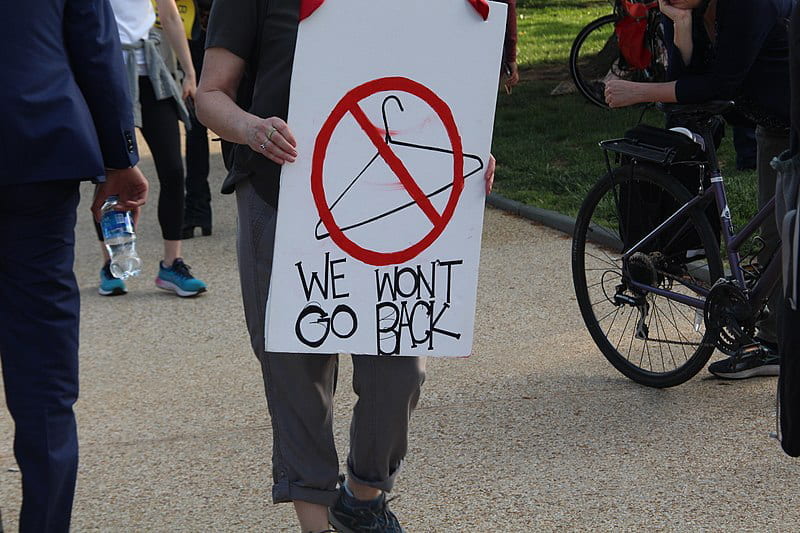
Jannie Rye (May 3, 2022). Signs at demonstration in front of SCOTUS. Wikimedia Commons.
Notes
[1] “150 Ways to Say Cornell: Regardless of Sex or Color,” Cornell University, accessed July 12, 2022, https://rmc.library.cornell.edu/cornell150/exhibition/sexcolor/index.html
[2] Sage Chapel Construction Records, #43-9-37. Division of Rare and Manuscript Collections, Cornell University Library., n.d.
[3] June F. Brooks Papers, #37-5-3886. Division of Rare and Manuscripts Collections, Cornell University Library.
[4] Linda Barufaldi. Interview by the authors. April 20, 2022.
[5] Diana Petitti. Interview by the authors. March 30, 2022.
[6] Jessica Bram. Interview by the authors. March 16, 2022.
[7] “The LeClair Affair.” Barnard College Archives, accessed July 12, 2022, https://barnardarchives.omeka.net/exhibits/show/introduction/leclairaffair
[8] “History: Always Innovating – landmark founding to present,” College of Human Ecology, Cornell University, accessed July 12, 2022, https://www.human.cornell.edu/about/history
[9] Cornell University Contraception, Gynecology and Sexuality Service Records, #51-1-2511 (folder 1). Division of Rare and Manuscript Collections, Cornell University Library.
[10] Rosalind Kenworthy Papers, #7731. Division of Rare and Manuscript Collections, Cornell University Library.
[11] Cornell University Contraception, Gynecology and Sexuality Service Records, #51-1-2511 (folder 2-3). Division of Rare and Manuscript Collections, Cornell University Library.
[12] “Sexual Health Care,” Cornell Health, Cornell University, accessed July 12, 2022, https://health.cornell.edu/services/sexual-health-care
[13] Samuel Buell, “Criminal Abortion Revisited,” New York University Law Review, 1991, 66 (6): 1774-1831.
[14] “CPI Inflation Calculator,” U.S. Bureau of Labor Statistics, accessed July 12, 2022. https://www.bls.gov/data/inflation_calculator.htm
[15] “Pregnancy Options,” Cornell Health, Cornell University, accessed July 12, 2022, https://health.cornell.edu/sites/health/files/pdf-library/pregnancy-options.pdf
Acknowledgements
The authors thank Linda Barafuldi, Jessica Bram, and Diana Pettiti for talking with us over Zoom. We also thank Ketchel Carey for collaborating with Xiyu Mei in the initial archival visit that launched this project as well as Teaching Assistant Xinlei Sha and Curator of the Human Sexuality Collection Brenda Marston for guiding student-led archival projects in the lecture course Introduction to Feminist, Gender and Sexuality Studies. Thanks also to Melina Ivanchikova and Rob Vanderlan for the chance to participate in this project.
